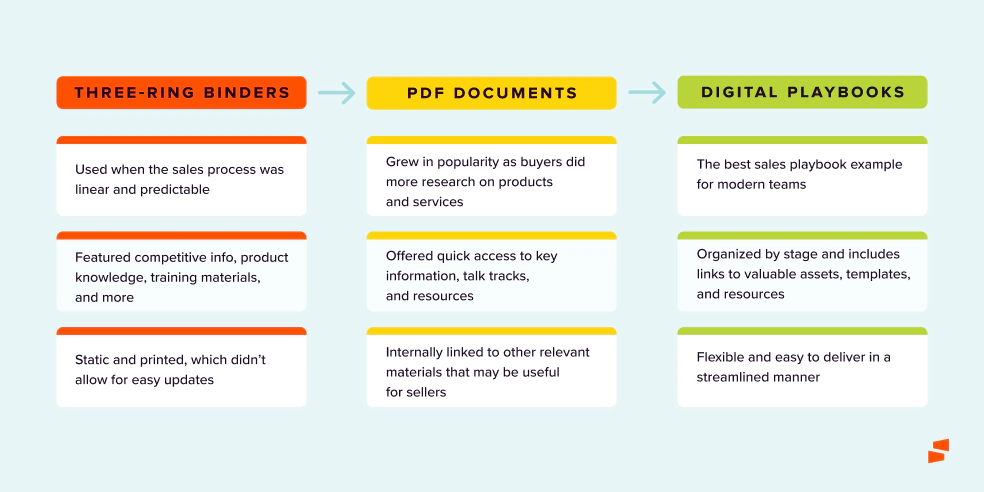As the buyer journey becomes more complex, marketing, sales and customer success teams have become responsible for a “shared task” creating highly relevant, personalised experiences for buyers.
In increasingly complex buyer journeys, go-to-market (GTM) teams have to be prepared to meet buyers where they are, answer detailed questions and provide relevant information. However, many companies don’t believe their sellers are equipped with the right skills or tools for these interactions, which leaves marketing and sales teams scrambling to find the best ways to help reps adapt and thrive.
This is where sales playbooks come in handy.
What is a sales playbook?
A sales playbook serves as a one-stop-shop for every frontline employee to find the information they need to tell a consistent story about a specific campaign, product or initiative. These guides include content and processes that support a unified experience throughout the buyer journey. They also feature best practices, tactics and strategies that should be used throughout the sales process or during a specific selling scenario.
These guides provide clarity on what to know regarding a specific product, what to say to prospects during a specific conversation or what to do in order to prepare for an interaction. This is a great way to codify, document and share best practices at scale with your entire GTM team so they sell more effectively, deliver exceptional support and improve your organisation’s bottom line.
The evolution of sales playbooks
Sales playbooks have been integral to sales success for decades. But, as buyer journeys have shifted, sales playbooks have also evolved. Let’s take a brief look at how far they’ve come in recent years.

Why are sales playbooks important?
We’ve already mentioned how helpful sales playbooks are when it comes to navigating rapidly changing sales processes and evolving buyer preferences. Sales playbooks also positively impact your entire GTM team and promote ongoing company growth. In fact, one study found that companies with well-defined sales playbooks and processes are 33% more likely to be high performers. The win rates also exceed 50% for two-thirds of companies that have these in place. If that isn’t encouraging enough, here are some of our other favourite benefits.
Decrease ramp time
New reps have access to a step-by-step guide that they can follow to engage with customers and learn important information.
Improve productivity
Because reps know where to find important information, they spend less time looking for what they need and more time interacting with buyers.
Drive consistency
Playbooks create and clear, concise and easy to follow processes for every function of the GTM organisation.
Increase effectiveness
By equipping sellers to navigate various scenarios, they can quickly and efficiently interact with buyers and close deals faster.
What should a modern playbook include?
The exact components of your sales playbooks will depend on a number of factors that range from your products and services to seller needs and preferences. However, every sales playbook should help employees identify:
- What they should know about the product, service or campaign the playbook focuses on.
- What they should say during specific scenarios or conversations.
- What content and information they should share to better engage with prospects.
- What else they should do – like watch a webinar, complete training or practise a pitch – to be better prepared.
Did you know?
Companies with well-defined sales playbooks are 33% more likely to be high performers.
What’s a sales play?
A sales play describes a set of repeatable steps, actions and best practices for employees to use during a specific scenario. Just like a sports playbook that’s made up of different plays and calls, a sales playbook includes a combination of different sales plays. These plays should provide context and clarity on what sellers need to do and how to do it. Most B2B sales playbooks should include the following items:
- Persona information: Who is your ideal customer profile?
- Key messaging and value props: What common challenges does your product or service help buyers solve?
- Objection handling tactics: Help sellers handle common objections with recommended handling skills and best practices.
- Discovery questions: Prepare sellers to ask questions that will help identify the needs of their buyers.
- Demo best practices: Detail and provide demo how-tos, suggestions and tips.
- Pricing and packaging details: Is this product one lump cost, per seat or both? Are there details on package options sellers need to know?
- Competitor analysis: How does your product or service compare to that of competitors?
- Use cases: Buyers want social proof and use cases are a great way to prove the success of similar companies.
- FAQs: Sellers and buyers will likely have additional questions, so provide a list of FAQs and answers that they can quickly reference.
- Training materials: A sales playbook is a great resource for quick info, but sellers may need to access additional training content to better understand the product or service they’re selling.
- Sales collateral: Buyers need relevant and personalised content throughout the buying process, so give sellers easy access to relevant materials and collateral they may find useful.
- Post-sales handoff details: Playbooks should also support post-sale activities including messaging for existing customers, renewal details and cross or up-sell details.
The Sales Playbook Blueprint

How to take a sales play from good to great?
There are several other factors and features that can take a sales playbook from good to great. In order to up-level your sales playbooks, we recommend that your playbooks also meet the following criteria.
Relevant
Sales playbooks are meant to be quick, in-the-moment need resources. So, it’s important to understand who your playbook’s audience is and what they need to know. This will help you identify what is most relevant and important to their role.
Contextual
Lengthy and text-heavy sales playbooks are inefficient. Instead, the best sales playbook examples are simple to access, navigate and understand for specific situations. Explain why you’re sharing certain information and include resources that enable sellers to understand how and when to use it.
Scalable and up-to-date
Remember the old, three-ring binders of yesteryear? These playbooks were difficult to update even with small changes. Digital playbooks are a great way to consistently update materials at scale.
Best practices for creating a sales playbook
Now that you know what the best sales playbooks include and why they’re so important, let’s explore how you can create a playbook of your own. Here are five quick tips to keep it mind when getting started.
- Simplicity is key: Remember sales playbooks are supposed to be quick reference guides. Look for ways to condense information and keep things as simple as possible.
- Use a sales playbook template: Standardisation is key for sales playbooks. A sales playbook template will ensure everyone on your enablement team creates consistent playbooks that follow the same organised structure, format and naming conventions.
- Find ways to engage your audience: Readers don’t want to sift through text-heavy documents. Look for ways to incorporate visuals and other elements that are more engaging for viewers.
- Make it user friendly: First, it needs to be easy to find the playbook. Then, it needs to be just as easy to read. Incorporate quick links, navigation and buttons so it’s easy to navigate and scan through sections.
- Measure for impact: The work isn’t over once you complete your playbook. The best enablement teams tap into data and analytics to see how the organisation is using the resource and make updates accordingly.
Maximising sales playbook success
We’ve helped thousands of GTM organisations deploy their own sales playbooks – so we’ve learned a thing or two about what separates subpar playbooks from the most successful ones. Here are three of our top suggestions to maximise your playbook’s success.
Include subject matter experts and teammates
Playbooks shouldn’t be created in a silo. Instead, enablement teams should work with subject matter experts across product or customer success teams to create the best content. It’s also helpful to ask a few sales reps to review your playbook before launching it to the rest of the organisation. They’ll be a great resource to ensure that the playbook achieves what you need it to do.
Timing is crucial
Timing is everything when it comes to activating your playbook for the GTM organisation. Consider what other initiatives and activities are taking place across the organisation and find the right window for launch. For example, if your team is approaching the end of a quarter, it doesn’t make sense to launch a new playbook that requires sellers to review and complete additional training within a week’s time. They’re already busy trying to finalise contracts and close deals and aren’t likely to engage with your playbook. Once you’ve identified the best time to launch a playbook, notify everyone through email or Slack so they’re informed.
Use a sales enablement tool
Sales playbooks require a lot of work and intentionality. Organisations that utilise a sales enablement tool find it easier and more efficient to create, deploy and update playbooks. These tools also include features that help enablement teams access playbook data and insights and set expiration dates so they can ensure content is always fresh.
Never stop growing.
Upgrade your old sales playbook
Does your GTM team still rely on old binders and static PDF playbooks? If so, it’s time for an upgrade. Our customers develop sales playbooks using Seismic’s content management tool, which offers the perfect digital playbook format. With Seismic Pages, sales and marketing teams can package helpful materials and content so sellers don’t have to waste time searching for items they need or reinvent the next steps in the sales cycle. By integrating playbooks in Seismic, sellers can quickly access them at the right time and when they need them most. To learn more about key elements of successful playbooks and to see Seismic Pages in action, get a demo.


